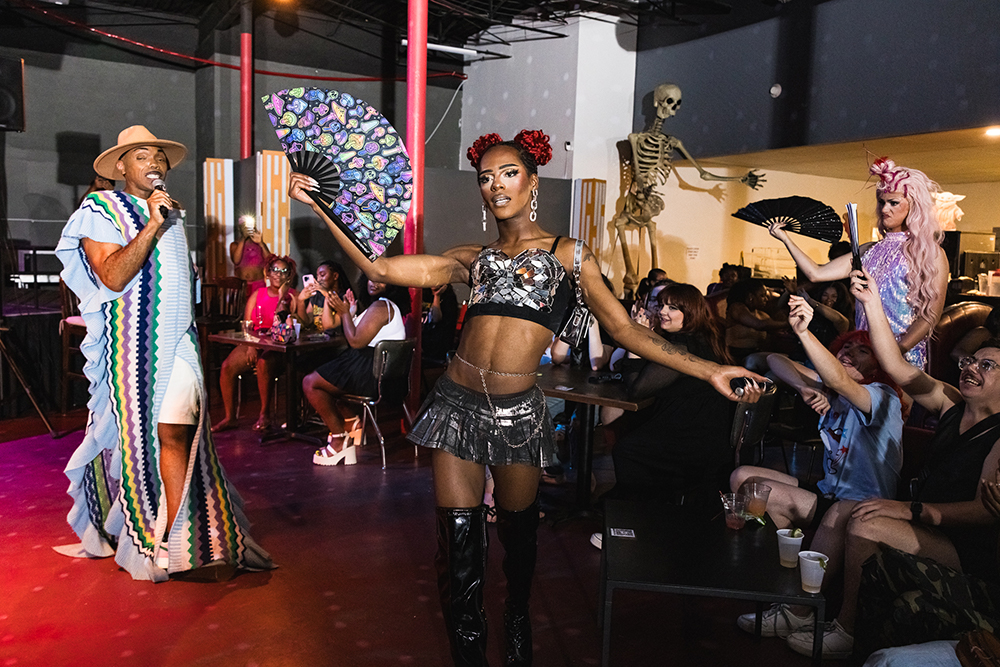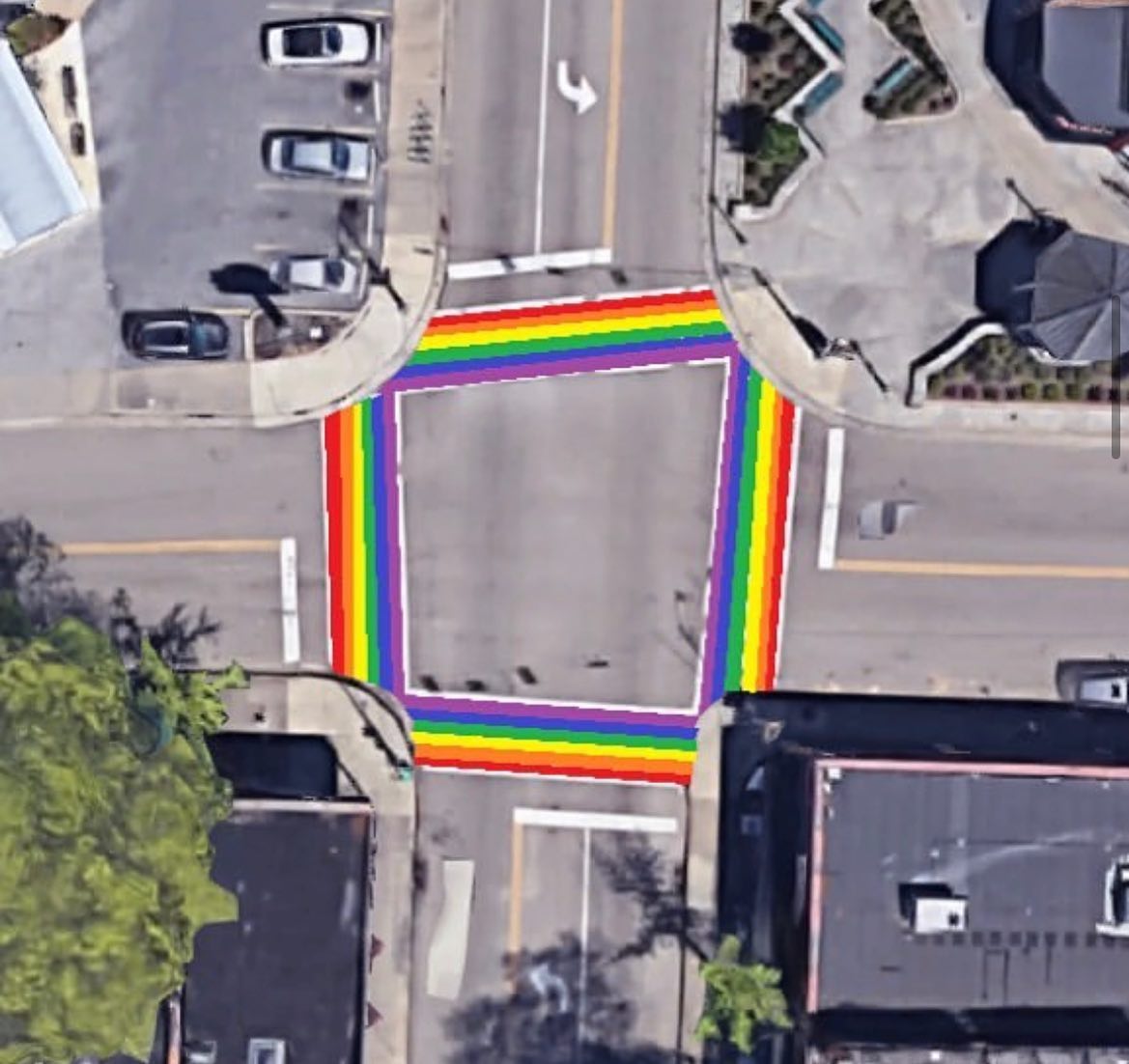On a late-June night, Caleb Armstrong stood in front of an intimate crowd at Black Lodge. It was among the venue’s final events before closing last month, which made this night — and the images captured — all the more special. Armstrong was readying to emcee an event he held close to his heart.
Donning a chic all-black ensemble and a pair of stiletto boots — playing with both masculine and feminine undertones — he grabbed the mic. The audience looked on, excited to be a part of the birth, or rebirth, of ballroom here in Memphis. Some posed and vogued in their seats. Outfits enhanced the ambiance — with people dressed in one-of-a-kind pieces that fit the night’s various performance categories.
Like a quiet storm, one participant commanded the room in a smart black suit and a hat ornately decorated with small crystals. As they flicked their fan, they had both the accessory and the audience in the palm of their hand. A sultry vixen would dramatically ditch her trench coat, leaving little to the imagination as she faced a shirtless competitor in the “sex siren” category. Rounds later, a woman sported what could be described as “model basics” — a simple black top and relaxed jeans. She would later reveal her secret weapon— a face card that scored 10s in the “face” category. Others wore fits ranging from streetwear to full-on drag. Regardless of garb, this would be a night to remember — with the promise of more to come.

A New Era
“Ballroom is back!” Armstrong exclaimed from stage, pulling power from his high heels. The 28-year-old fitness instructor and longtime ballroom aficionado was seeing the end product of a long-sought dream and a much-anticipated revival.
This was one of those pinch-me moments for Armstrong. And he’s experienced those more frequently in the past few years. (Read on to hear about his brush with Beyoncé.)
This night was about ballroom, which may not be what you associate with “ballroom,” and doesn’t involve celebrities competing to revive their careers. Still largely underground, ballroom can be thought of as the ultimate face-off, with the collateral being pride, ferocity, and the ability to “serve.”
Participants come dressed in their best representation of the competition’s categories, mixed with the theme of the function. In a “sneaker vs. sneaker” face-off, one may choose to break out a sought-after pair of Jordans to go head-to-head with Comme des Garçons Converse, with the defining element being how the contestant sells the look to the audience and judges. Those in the “body” category may rely solely on their weekend Pilates classes and physiques to flex their goodies.
Outfits and presentation are only part of what the judges score. To receive 10s across the board, the contestant must command the room — marking every corner with their uniqueness and fierceness — thus garnering snaps, fan flicks, and audience applause.
If the judges like what they see, they’ll use their hands to display all 10 fingers to signify a vote of confidence. Those who compete in a category either receive “10s across the board” or are “chopped.”
Historian Tito Giuseppe’s presence at Black Lodge that summer night was notable. With his wealth of knowledge and experience, some might say he is ballroom history. He’s also the founder of the House of Giuseppe (more on “houses” later).
“Shout out to Black Lodge! Can we give it up for Black Lodge, y’all?” Giuseppe said as he joined Armstrong on stage and took the mic. “You all right now are a part of ballroom history. You people here tonight are really a part of an evolving culture that has been around for 53 years — and it’s making a resurgence here in your backyard.”
It was a night that was years in the making, one that encapsulated lifelong passions, a history spanning decades, and the desire to revive a sacred space for community in Memphis. Giuseppe called the night — the first ballroom event in Memphis in a long time — “groundbreaking,” and those who were lucky enough to witness it would agree.
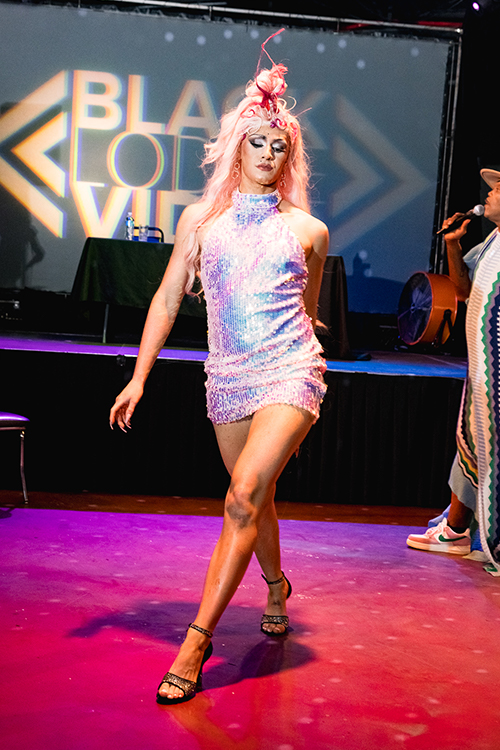
Lessons in Serving
Giuseppe, who grew up in the North but now lives in Memphis, dates his entry into ballroom back to 1989 when he was a student at Howard University in Washington, D.C. Back then, there wasn’t representation of ballroom on TV or in the media. He says when he coaches and talks to the new guard, he wants them to understand the foundation upon which they’re building. While he believes there are upsides to increased exposure in popular media — including the iconic documentary Paris Is Burning, Ryan Murphy’s Pose, the ballroom competition show Legendary, and Beyoncé’s album Renaissance — understanding the culture’s origins before such exposure is crucial to its longevity and respect.
“Everything still stems back from 1971, when they started,” Giuseppe says. “[Things like] how you’re being judged, 10s and a chop [which essentially denotes a win and a loss] — those things stem from 53 years ago in its inception.”
As someone who lived in the movement during its golden era, Giuseppe today considers himself both a mentor and educator in the South, encompassing Texas, Louisiana, Arkansas, Oklahoma, Tennessee, and Mississippi. He says he is often approached by different houses in these areas to help cultivate and grow the culture.
“This is a teaching moment because we want you to understand. We don’t want you to say, ‘Oh my gosh, I’ve seen this on YouTube and now I get to see it in person,’” Giuseppe told the audience. “No. I want you to walk away with a knowledge of what this is. Not only do you educate yourself, but you get to talk about it with your girlfriends.”
Giuseppe says ballroom is known to have started in 1971 by Crystal LaBeija and Pepper LaBeija as a way to rebel against the prejudiced practices in drag pageants. The two African-American people of trans experience would enter events similar to drag pageants (also known as drag balls). While the LaBeijas were “really, really good,” they would never find themselves past first-runner up in a mostly Caucasian-dominated culture.
The LaBeijas’ original ballroom functions aimed to address the inequities in the drag space in that era, and, over time, Giuseppe says, they evolved. Today, people of all races, cisgender folks, and heterosexual women have dominated in the performance
categories.
“It’s an underground culture that allows those of us who are participants in the culture to compete in different categories like ‘face,’ ‘realness,’ ‘runway,’ ‘body,’” Giuseppe says. “Think of it as the Olympics, so to speak.”
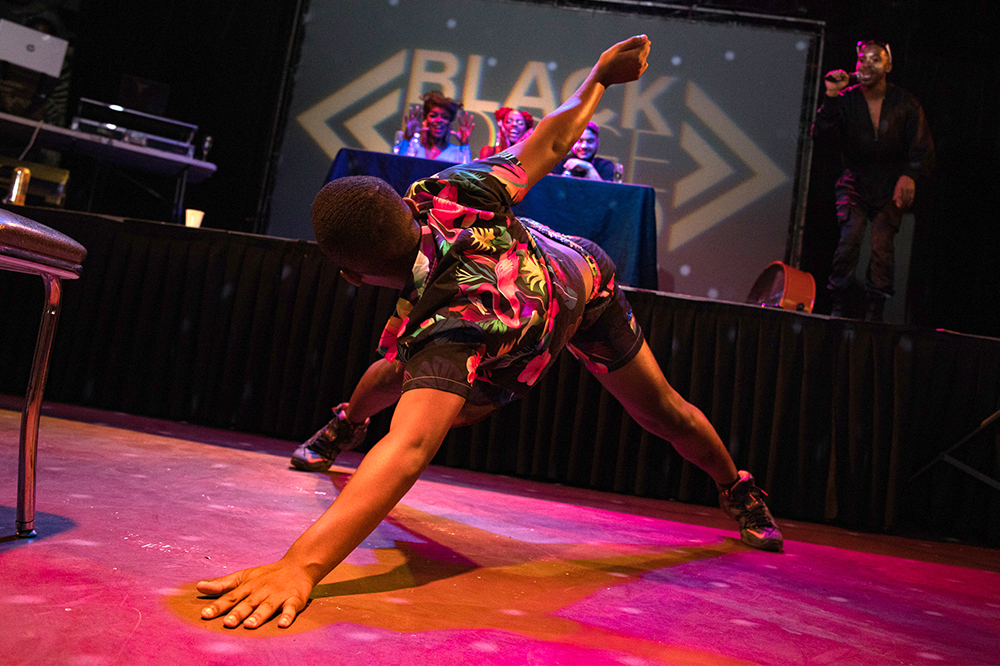
And “houses” are an integral part of ballroom culture. They serve as teams for participants — who aim to bring honor to said teams with trophy wins. They’re also considered chosen family. The houses are often named after luxury designers and fashion brands, such as Hervé Léger, Thierry Mugler, or Balenciaga, Giuseppe says, and “the house itself operates under a name, and those members are all considered ‘house members,’ but they operate like a family.”
The founders of these houses are considered founding mothers and fathers. Giuseppe, for example, is the founding father of the House of Giuseppe. There are then a set of “overall parents,” who, although they did not start the house, operate them on a “day-to-day basis from a wide standpoint,” he says.
“All of the chapters from the various cities, states, and countries answer to those two overall parents,” he says. “Then you have state parents, like a Texas mother and father, a Tennessee mother and father, and then it breaks down into cities. … They compete in those regions as the house itself.”
The idea of a chosen family is appealing to many, which is why people like Armstrong turn to ballroom for a sense of community. After coming out publicly “five or six years ago,” he sought to figure out his identity beyond sexuality. And that’s precisely how he “stumbled into the ballroom world.”
“I really admire the framework of the chosen family relationships that ballroom is founded on,” Armstrong says. “I think that’s kind of the heart of ballroom. I really spent years looking for genuine friends, and cultivating those friendships and relationships.”
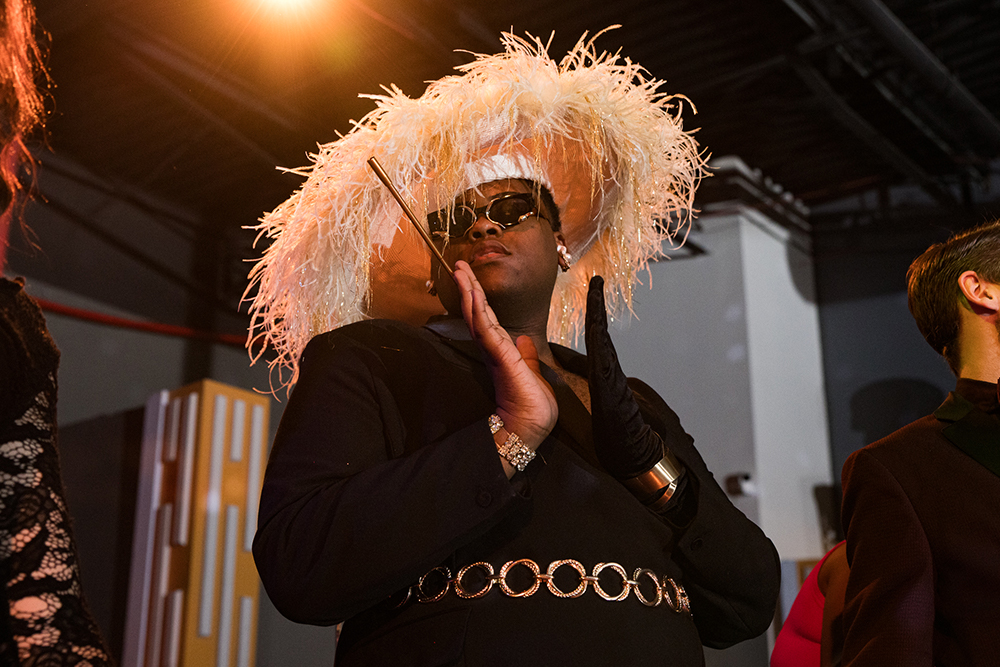
A Revival With Purpose
The summer ball at Black Lodge was the brainchild of Armstrong and his closest friends — with the help of Giuseppe. During the event, one of those friends, Octavia Jones, commonly referred to as DJ Space Age, or Space Age, kept the runway booming and the vibes copacetic. In June of 2022 Jones launched Queer Memphis, an organization dedicated to curating networking and social events in hopes of creating more spaces and events for the local queer community. In her 15 years as a DJ, Jones has been able to see “what isn’t happening and things people wanted to see.”
Jones has attended ballroom events, but they’re “few and far between” in the city, happening once or twice a year, she says. Recognizing that dearth evolved into collaborating with Armstrong and others to put on their first ballroom event this June, with the hope of establishing consistency.
“I haven’t seen anything that’s been consistent, I think, ever in the city of Memphis,” Jones says. “I know myself and especially Caleb have attended balls outside of Memphis, in New York, Nashville, and Atlanta. We kind of ended up talking about just pressing the reset button and activating something in Memphis.”
The culture and history are the major draws for Jones, who feels ballroom serves as a way for the LGBTQ community to take a multifaceted approach to self-expression. And she wanted to have a hand in giving people more outlets to express themselves beyond the local drag scene, producing events such as the one at Black Lodge.
Cheri Lie Maid, a Memphis drag performer and ballroom enthusiast, served as one of three judges at the event, alongside Mariah Da’Goat Kelly and Juan Martinez. Cheri says their affinity for makeup and LGBTQ
culture led them to discovering ballroom, which served as an entry point into drag.
“I came across ballroom on YouTube and the first thing I was watching was a butch queen up in drag — a man who is in makeup, or in hair and heels, performing ballroom voguing but in a different element, basically,” Cheri says, “which means it’s feminine and not like old-wave or new-wave.”
There are some drag elements in ballroom, as it was birthed from that art form, Cheri says. But there are also elements of ballroom in drag. And while ballroom was Cheri’s first love, drag serves as a way for them to marry that interest with a love of makeup.
“Ballroom is very much a masculine field and a feminine field,” Cheri says. “We understand that those two are very humanly categorized, so we tend to think those are the only two categories we can go through, that it’s either/or. Some people like to play with both.”
This is part of what Cheri appreciates about ballroom though — it’s made to encompass and welcome as many queer people as possible.
“That’s what it means to be a part of the LGBTQ community,” Cheri says, “because you know what you are and you know what you present, but it’s better for you to be among your people who want to bring you up and see you as a better person.”
Armstrong echoes these sentiments, as he drew inspiration from the iconic OTA (open to all) Balls in New York. He wanted to incorporate these themes not only into his events but also into the community he hoped to create out of them. He knew ballroom had more to give than just an experience.
“When I was looking for friends, I was looking for friends who had that special light but needed a platform to showcase that,” Armstrong says. “A lot of my friends are drag queens. We are in the club bucking it, twirling it every weekend, giving a look — being those girls. I think a piece of that goes back to representation and visibility. I try to be the person I wanted my inner child to see growing up.”

This Is What I Wanna See
For Armstrong, things have come full circle. He remembers watching a “nasty” Vogue Femme Final ballroom battle between Lasseindra and Ida “Inxi” Holmlund on YouTube in 2015 and being captivated by the subculture for the first time. Fast-forward to being featured in a project praised for its contributions to both pop culture and queer iconography.
In one of the biggest flexes of the 21st century, Armstrong was able to add the credit “Featured in Renaissance: A Film By Beyoncé” to his Instagram bio.
“My friends will tell you they are sick of me,” Armstrong says with a laugh. “I’ll be like, ‘Do y’all know that Beyoncé knows me?’ I’ve loved her for so long, and to be featured and recognized by not only Beyoncé but that project specifically holds such a special place in my heart. Renaissance obviously did something for the Black queer culture that can’t be undone, and it represents us so well.”
That project was the 2023 musical documentary that was the culmination of Beyoncé’s summer tour celebrating her seventh studio album, a blend of Black dance music, disco, and house, with samples from Donna Summer, Teena Marie, Moi Renee, Big Freedia, and more.
Armstrong remembers getting into Club Renaissance and being thrust into a full-on vogue-off prior to Beyoncé taking the stage. Not only did his infectious energy catch the attention of Beyoncé’s team, his bold, fringed, silver two-piece outfit in the tour’s TV-test screen set (ingeniously modeled after the Progress Pride flag) truly defined being “the visual.”
“For her to see me, that was my most joyous, my most authentic [self]. … I was feeling opulent, I was feeling ova [high], I was feeling the fantasy,” Armstrong says. “For me to be my complete, extra, over-abundant self and for her to see me and amplify it even more … it was the biggest love letter.”
Representation is an important part of an individual’s path to authenticity, and, like many things in queer culture, it is not monolithic. While people are familiar with some of what Memphis LGBTQ life has to offer, they’ve only gotten a taste. In the absence of consistent ballroom culture here, many travel to other cities. Giuseppe encourages people to experience it. Cheri does too, and believes no one should have to travel for it, as it has the ability to touch and change lives — like it did theirs.
This ballroom revival gives Memphis a chance to be a part of history while adding the city’s own signature. Cheri, Jones, and Armstrong have seen the way culture builds on top of itself, through people like Giuseppe, and through visiting places where the scene originated. They’re respecting tradition while building on that foundation. Their dreams are as big as the groundwork laid before them, and they know the legacy they’re stepping into.
“We have our own style, our own culture here,” Armstrong says. “Why don’t we cultivate that? Let’s put Memphis on the map. I feel like Memphis, no shade, we’re a Southern city, so we’re very ‘banjee’ [have swagger]. We’re very gritty, very raw. … Once we continue with the balls, our style will create its own signature and [people will be able to] say, ‘Oh, that’s a Memphis girl. … Oh, we see Memphis is in the house, we see how she’s bucking it.”
Ready for more Memphis ballroom? Prepare to mash at Atomic Rose’s Monster Ball on October 25th. Visit @QueerMemphis on Instagram for updates.
